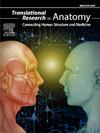Mesorectum volumetry in males with rectal cancer: Variabilities observed in pre- and post-neoadjuvant radiotherapy imaging
Q3 Medicine
引用次数: 0
Abstract
Purpose
This study utilised magnetic resonance imaging (MRI) to describe the within population variations and the variability observed in the volumetry of the mesorectum pre- and post-neoadjuvant radiotherapy, prior to surgical intervention, in a South-African sample of males with rectal cancer.
Methodology
Nineteen pelvic MRI scans of males diagnosed with rectal cancer, who underwent neoadjuvant long-course radiotherapy (LCRT) or short-course radiotherapy (SCRT) prior to undergoing a total mesorectal excision (TME), were retrospectively reviewed and analysed. Mesorectal volume was calculated after contouring individual axial slices and creating a three-dimensional compounded structure on both pre- and post-radiotherapy scans, which were subsequently described and compared.
Results
Both pre- and post-neoadjuvant radiotherapy mesorectal volumetry displayed great variability. Mean calculated pre-radiotherapy mesorectal volume was 272.94 ± 80.30 cm3. Post-radiotherapy volume equated to 239.19 ± 81.30 cm3, presenting an overall percentage decrease of 12,60 %, resulting in a statistically significant difference (p = 0.001). In sub-group analysis, both patient groups who underwent LCRT and SCRT showed a general decrease and statistically significant difference in mesorectal volume post-radiotherapy when compared to pre-radiotherapy imaging.
Conclusion
Significant variation in the volumetry of the mesorectum pre- and post-neoadjuvant radiotherapy observable on MRI can have important clinical implications for the TME. A change in mesorectal morphometry may require modification of the planned surgical strategy. Therefore, the information obtained from a post-radiotherapy MRI prior to surgical intervention, can be a worthwhile addition to the available armamentarium for surgeons to guide surgical decision-making, encouraging the adoption of optimal individualized and novel treatment strategies to improve patient outcomes.
男性直肠癌患者的中直肠容积测量:在新辅助放疗前后成像中观察到的差异
本文章由计算机程序翻译,如有差异,请以英文原文为准。
求助全文
约1分钟内获得全文
求助全文
来源期刊

Translational Research in Anatomy
Medicine-Anatomy
CiteScore
2.90
自引率
0.00%
发文量
71
审稿时长
25 days
期刊介绍:
Translational Research in Anatomy is an international peer-reviewed and open access journal that publishes high-quality original papers. Focusing on translational research, the journal aims to disseminate the knowledge that is gained in the basic science of anatomy and to apply it to the diagnosis and treatment of human pathology in order to improve individual patient well-being. Topics published in Translational Research in Anatomy include anatomy in all of its aspects, especially those that have application to other scientific disciplines including the health sciences: • gross anatomy • neuroanatomy • histology • immunohistochemistry • comparative anatomy • embryology • molecular biology • microscopic anatomy • forensics • imaging/radiology • medical education Priority will be given to studies that clearly articulate their relevance to the broader aspects of anatomy and how they can impact patient care.Strengthening the ties between morphological research and medicine will foster collaboration between anatomists and physicians. Therefore, Translational Research in Anatomy will serve as a platform for communication and understanding between the disciplines of anatomy and medicine and will aid in the dissemination of anatomical research. The journal accepts the following article types: 1. Review articles 2. Original research papers 3. New state-of-the-art methods of research in the field of anatomy including imaging, dissection methods, medical devices and quantitation 4. Education papers (teaching technologies/methods in medical education in anatomy) 5. Commentaries 6. Letters to the Editor 7. Selected conference papers 8. Case Reports
 求助内容:
求助内容: 应助结果提醒方式:
应助结果提醒方式:


